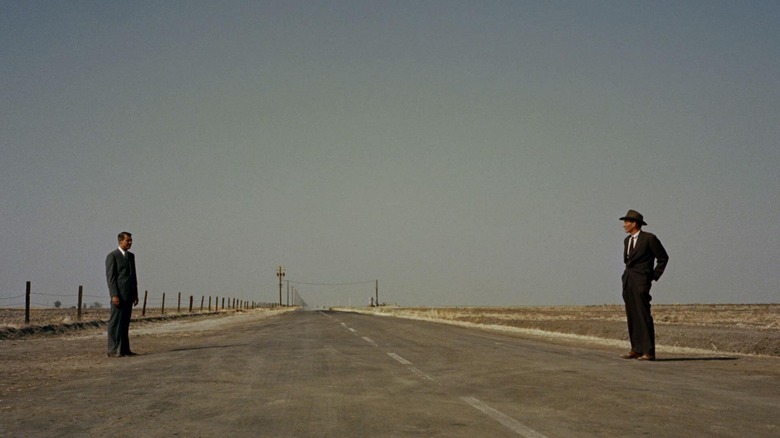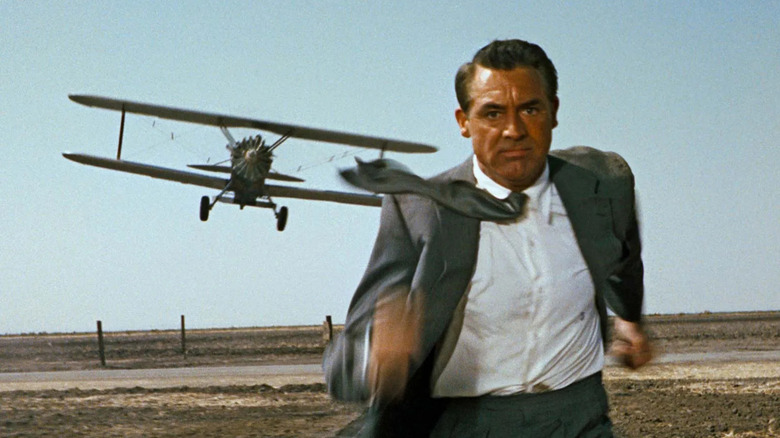North By Northwest's Best Scene Was Alfred Hitchcock's Way Of Dodging A Suspense Cliche
Nestled between the heartsick duplicities of "Vertigo" and the urgent duality of "Psycho" sits one of Alfred Hitchcock's most celebrated action thrillers, a story swirling in vanishing identities and betrayal. "North by Northwest" is the English director's 1959 spy film with an Oscar-nominated screenplay written by "Hello Dolly!" scribe Ernest Lehman, and it concerns an innocent man (Cary Grant) hounded by international saboteurs in a case of mistaken identity. Filled with common Hitchcock situations while staying unpredictable, the movie has found incredible lasting power beyond the Cold War years it's set in.
Above all, the "Psycho" director wanted to disrupt the common approach of action pictures, which often positioned the hapless hero in predictable moments. In the 2014 collection of writings and interviews, "Hitchcock on Hitchcock," the filmmaker describes the "rain-washed cobbles shining in the night" where these spectacles are usually set; a figure peeks from the shadows, a black limo pulls up and shots ring out. Hitchcock points out how mundane it's gotten, and how he worked around it:
"Well of course, this is such a cliche thing, you see, that one has to fight shy of it and run as far away from it as one possibly can because it's all predictable. The audience has seen it so many times, students of the cinema are so familiar with it. Now I decided to do something quite different and I say to myself, What shall I do? Well, let's have it with nothing so that the audience will have no conception as to how this man is going to be bumped off or shot. So therefore, I take the loneliest, emptiest spot I can so that there is no place to run for cover, no place to hide, and no place for the enemy to hide, if we can call him that, you see."
1,000 ways to die
Cary Grant's Thornhill is one of the most-used types in Hitchcock pictures, an ordinary person out of their element, like Guy Haines in "Strangers on a Train" or the McKennas of "The Man Who Knew Too Much." Thornhill cuts a diminutive silhouette against the vast midwest roadside, visually prompting the audience to speculate on how their intrepid hero might be dispatched. Drive-by shooting? A roadside stabbing? All is possible with the Master of Suspense, whose aim in the crop dusting sequence was to keep everyone guessing.
The scene begins with Thornhill placed on a rural road, the starting point of what Hitchcock describes as a "train of thought in the audience" that features passing cars, a mysterious stranger, and finally an out-of-place airplane as potential killers. Hitchcock incrementally dials up the suspense until the third threat – the crop dusting plane – drives Thornhill into a cornfield. This, Hitchcock says, is where the grand design makes it worthwhile:
"There is no cover until he gets into the cornfield. Now, you do in the design a very important thing. You smoke him out with the very instrument that you're using, a crop duster. Theory being, don't have a crop duster without your using it, otherwise you could have any airplane. So the dusting of the crop, the dust rather from the crop duster, smokes him out of the cornfield and he dashes in front of the truck desperately and the plane makes a last dive, mistimes it. Or the truck does come to a stop by his frantic waving and out goes the whole lot. So you see, this is by design."
Wrongly accused men are frequent players in the Hitchcock catalogue, but "North by Northwest" interrupts the model with little more than an open road on a barren field, and it's now one of the most memorable moments in cinema history.

